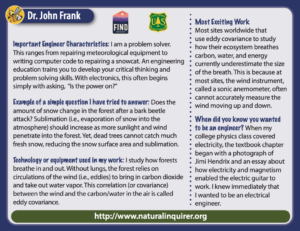Carbon
Learn more about the carbon cycle, carbon storage, gas exchange, urban trees, and more with a variety of Natural Inquirer resources. Browse by topic, grade band, and resource type.
-
 The Caves and Karst edition of Natural Inquirer examines research on a variety of topics including white-nose syndrome in bats,…
The Caves and Karst edition of Natural Inquirer examines research on a variety of topics including white-nose syndrome in bats,…The Caves and Karst edition of Natural Inquirer examines research on a variety of topics including white-nose syndrome in bats, karst forest areas, cave use of an indigenous tribe of…
-

 Forests & Plants
Forests & PlantsLinda Heath, Research Forester

- Ph.D., University of Washington
- USDA Forest Service Scientist
- I study ways to provide estimates of multiple environmental benefits. An example of a benefit is forest carbon. The estimates are needed at local to national to global scales.
- Ph.D., University of Washington
- USDA Forest Service Scientist
- I study ways to provide estimates of multiple environmental benefits. An example of a benefit is forest carbon. The estimates are needed at local to national to global scales.
-

 FireForests & PlantsWeather & Climate
FireForests & PlantsWeather & ClimateMichael Gavazzi, Biological Scientist

- M.S., Virginia Tech
- USDA Forest Service Scientist
- A biological scientist is a jack of all trades. I work with other researchers in diverse disciplines to study forest ecosystems response to prescribed burning, climate change, and natural and man-made disturbance.
- M.S., Virginia Tech
- USDA Forest Service Scientist
- A biological scientist is a jack of all trades. I work with other researchers in diverse disciplines to study forest ecosystems response to prescribed burning, climate change, and natural and man-made disturbance.
-

 Forests & PlantsSoil
Forests & PlantsSoilGrant Domke, Research Forester

- Ph.D., University of Minnesota
- USDA Forest Service Scientist
- As a forester, I study carbon dynamics in forest ecosystems. I develop and improve techniques to estimate forest carbon stocks and changes to the carbon stocks using forest inventory information.
- Ph.D., University of Minnesota
- USDA Forest Service Scientist
- As a forester, I study carbon dynamics in forest ecosystems. I develop and improve techniques to estimate forest carbon stocks and changes to the carbon stocks using forest inventory information.
-

 Forests & PlantsWaterWildlife
Forests & PlantsWaterWildlifeRobert Deal, Research Forester

- Ph.D., Oregon State University
- USDA Forest Service Scientist
- As a research forester, I conduct research on applied silviculture. Silviculture is the art and science of establishing and growing trees to meet the needs and values of landowners.
- Ph.D., Oregon State University
- USDA Forest Service Scientist
- As a research forester, I conduct research on applied silviculture. Silviculture is the art and science of establishing and growing trees to meet the needs and values of landowners.
-

 FireForests & PlantsInsectsWater
FireForests & PlantsInsectsWaterKenneth L. Clark, Research Forester

- Ph.D., University of Florida
- USDA Forest Service Scientist
- A research forester studies forest composition, structure, and functioning, such as productivity and nutrient cycling.
- Ph.D., University of Florida
- USDA Forest Service Scientist
- A research forester studies forest composition, structure, and functioning, such as productivity and nutrient cycling.
-

 Forests & PlantsWaterWildlife
Forests & PlantsWaterWildlifeDon C. Bragg, Project Leader & Research Forester

- Ph.D., Utah State University
- USDA Forest Service Scientist
- Foresters study many aspects of trees and forests, from traditional silviculture to carbon storage to the relationship between humans and trees. My forestry research concentrates on the ecology and management of pine forests in the southern United States.
- Ph.D., Utah State University
- USDA Forest Service Scientist
- Foresters study many aspects of trees and forests, from traditional silviculture to carbon storage to the relationship between humans and trees. My forestry research concentrates on the ecology and management of pine forests in the southern United States.
-

 Forests & PlantsSoilWaterWeather & Climate
Forests & PlantsSoilWaterWeather & ClimateJulie A. Arnold, Forestry Technician

- B.S., Clemson University
- USDA Forest Service Scientist
- As a forestry technician in the research field, my work is a balance of field work (i.e., collecting samples, taking measurements, and downloading dataloggers), lab work (i.e., sample preparation and analysis), and data processing (i.e., creating spreadsheets, charts, and graphs).
- B.S., Clemson University
- USDA Forest Service Scientist
- As a forestry technician in the research field, my work is a balance of field work (i.e., collecting samples, taking measurements, and downloading dataloggers), lab work (i.e., sample preparation and analysis), and data processing (i.e., creating spreadsheets, charts, and graphs).
-

 Forests & PlantsWeather & Climate
Forests & PlantsWeather & ClimateJohn Frank, Electronics Engineer

- Ph.D., University of Wyoming
- USDA Forest Service Scientist
- An electronics engineer in the Forest Service usees math, physics and computers to design circuits, write programs, and build instruments to answer questions about how our forests function.
- Ph.D., University of Wyoming
- USDA Forest Service Scientist
- An electronics engineer in the Forest Service usees math, physics and computers to design circuits, write programs, and build instruments to answer questions about how our forests function.





